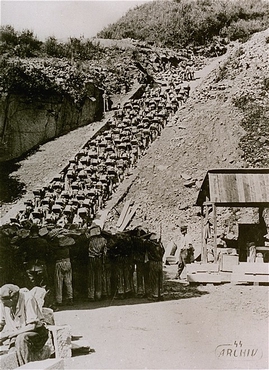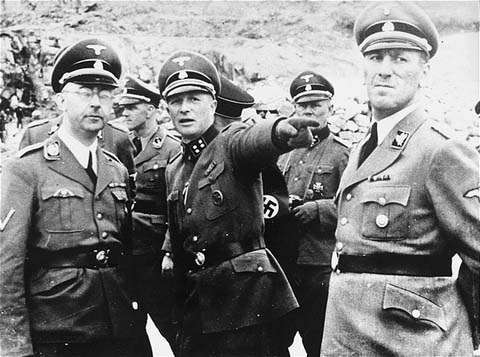Key and copyright. (In Czech)
The first prisoners came to Mauthausen concentration camp from Dachau on the 8th of August 1938, just under five months after the Anschluss of Austria by Nazi Germany. Lying some 20 km east of Linz, close to the small town of Mauthausen, It was the first concentration camp outside of Germany's own territory.
The camp fell into the grade III
category for prisoners deemed incorrigible, whose return was not desired. Mauthausen was one of the Nazis' worst exterminating concentration camps. The prisoners were subjected to brutal treatment, were driven into electric fences and killed using petrol injections. Extermination took place on a mass scale in gas chambers and a mobile gas bus. The worst, however, was the mental torture and harsh physical labour, especially in the quarry, where prisoners were forced to walk in columns up the stairs of death
, 186 steep steps cut into the granite, carrying large blocks of granite on their backs. They had to do this several times a day, without resting, while continually being beaten and shot at. There were also infamous sadistic murders known as "parachute jumps," in which SS men would select victims on the level at the top and then throw them off the cliff into the lake.

The stairs of death
in the Wiener Graben quarry. (Photo: Archiv der KZ-Gedenkstätte Mauthausen, courtesy of USHMM Photo Archives .)
The largest national group at the camp consisted of Poles. Before spring 1941, only very few Jews were sent to the camp. Only later were Jewish transports sent to the camp, the first coming from Bohemia. Jews in Mauthausen were treated even more brutally than the other prisoners, and their chance of survival was minimal. From mid-1944 labour transports came to Mauthausen from Auschwitz, Plaszow and other camps. In 1945, prisoners who had managed to avoid the selections at Auschwitz were evacuated to Mauthausen. Like the Russian prisoners of war before them, they were left out in the open in the tent camp
, exposed to terrible weather. Thousands of prisoners died of hunger, since their already short rations were cut further. There were even cases of cannibalism in the camp.

Camp commander Franz Ziereis (centre) with Heinrich Himmler (left) in the quarry during an inspection of the Mauthausen concentration camp. (Photo: Archiv der KZ-Gedenkstätte Mauthausen, courtesy of USHMM Photo Archives.)
The prisoners were mostly used to dig tunnels for the underground factories that were being built in the area. Mauthausen's best-known auxiliary camps were Gusen, Ebensee and Melk, where conditions were just as horrific.
The total number of prisoners in Mauthausen is estimated at 199 404, of whom 119 000 died. They included 38 120 Jews.
The camp was liberated by the 11th armoured division of the US Army. The commander of the concentration camp, Franz Ziereis, was shot while trying to escape, and subsequently died. 58 members of the SS were sentenced to death, and three to life imprisonment.
-
See also:
-
Testimony of Mr. Artur R., born 1921. From Radvanice near Ostrava he escaped to Poland. He was arrested and interned in the concentration camps at Buchenwald, Ravensbrück (link in Czech), Sachsenhausen and finally Mauthausen, where he survived until liberation. (In Czech)
-
Literature:
-
Horwitz, Gordon J. In the Shadow of Death: Living Outside the Gates of Mauthausen (Im Schatten des Todes). New York: Free Press, 1990. 236 p.
-
Marsalek, Hans. Die Geschichte des Konzentrationslager Mauthausen. Wien: Österr. Lagergemeinschaft Mauthausen, 1974. 319 p.
-
Berdych, Václav. Mauthausen: K historii odboje vězňů v koncentračním táboře Mauthausen (Über die Geschichte des Häftlingswiderstands im Konzentrationslager Mauthausen). Praha: Naše vojsko, 1959. 247 p.